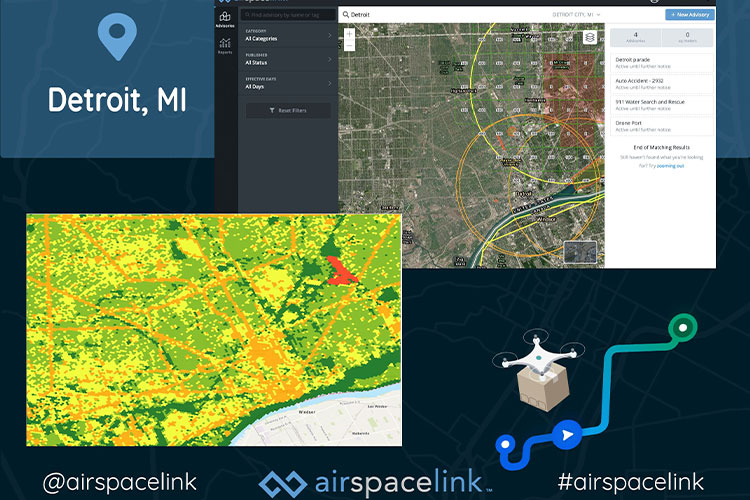
AirSpace Link
Building aerial highways and the maps and rules to navigate them from right here in Michigan.
To some people, a drone is a toy, like a radio-controlled race car, airplane, or sailboat in a pond. To others, operating a drone is a high-end hobby.
Increasingly, though, drones are becoming vital commercial and industrial tools. Oil and gas companies use them to check hard-to-access pipelines for leaks. Agronomists use them to collect data on soil use. Farmers use them to monitor crop development. Maybe most visibly and most recently, they are being tested for delivery service applications for packages, medical supplies and even home meals.
Ultimately, drones represent a new mobility opportunity for leveraging airborne - and potentially autonomous - vehicles.
As of January 2021, there were nearly 1.8 million drones registered in the U.S. by the FAA. And thanks in part to new FAA regulations, that number is expected to grow significantly in coming years.
According to some forecasts, the drone market will grow to $63.6 billion by 2025.
To current and prospective drone operators, all that airborne traffic presents challenges and raises questions. For example:
With potentially millions of low-altitude drones in the sky operating below 400 feet (the maximum allowable altitude for drones), how will air traffic be managed and where will it be safe to fly? How will government protocols be integrated and whose aircraft will take precedence?
Enter AirSpace Link with answers.
AirSpace Link is a venture of co-founder and CEO Michael Healander, whose background is building geospatial applications like the location mapping tools used by Target on its mobile application. His creative insight in conceiving AirSpace Link emerged from a recognition that the prospect of widespread commercial drone usage posed distinct challenges. In particular, he saw the growing need for an aerial mapping and routing system analogous to those used for ground-based vehicles, a kind of aerial Waze or Google Maps.
Of course, those navigation applications are based on existing road and highway infrastructure. Low altitude, unmanned aerial vehicles (UAVs, sometimes referred to as unmanned aerial systems or UASs) have no such infrastructure. So aerial infrastructure was also part of Healander's vision, along with the rules of the road to navigate it.
The result was AirSpace Link's cloud-based platform, AirHub, which focuses on integrating state and local governments' need to regulate their airspace with the route planning tools pilots currently use.
The Michigan Economic Development Corporation (MEDC) was instrumental in getting the company off the ground, figuratively speaking, as the state’s leading expert on transportation mobility and electrification.
Through MEDC support, Michigan emerged as both the logical and the ideal place to turn Healander's insight into a business. Logical, thanks to Michigan's role as the world leader in automotive and mobility R&D. Ideal because - through its leadership - Michigan is a nexus of highly focused interest, expertise, networking opportunities, and venture capital available to mobility-related start-ups.
"MEDC has been instrumental at virtually every phase of AirSpace Link's growth to date," Healander said. "We started with three founders in the state’s collaborative workspace in downtown Detroit and ended up getting our own office there. The funding we received from the state’s mobility grant allowed us to grow initially, beta test our product with live customers, commercialize it, and develop a use case study we could take to other states and agencies. MEDC connected us with other investors, which helped us grow from three employees to 17 today and 40 by year's end."
The funding from MEDC plus venture capital also helped AirSpace Link weather the COVID-19 pandemic and use it to gain the benefit of additional experience.
"We made a strategic decision to switch from a revenue focus, to spend 3 to 6 months just getting customers into our system and, in effect, plotting out the aerial highways using the data we collected, "Healander said. "This year, we're all about turning that data into paid infrastructure."
In May 2021, the team also announced the completion of a $10-million series A capital raise, allowing them to continue paving the way for the drone economy.
Healander also sees potential economic spin-off benefits for Michigan through AirSpace Link's growth. For example, as the company’s infrastructure product gains acceptance, it will spur the manufacture of increasing numbers of drones. Depending on their applications, many of these will, by law, must be built in the U.S., with Michigan likely to become a favored manufacturing site. And Michigan's combined experience with mobility and aerial infrastructure will make it an attractive base for developing advanced air mobility applications, like air taxis.
No matter where the road – or sky – takes them, AirSpace Link knows that the MEDC will be there to support them every step of the way.
To learn more about Michigan’s mobility ecosystem supporting the growth of AirSpace Link, please visit michiganbusiness.org/mobility. And to hear Michael Healander speak with MEDC in more detail about how AirSpace Link is driving innovation in this arena, go to michiganbusiness.org/podcast to listen to Michael’s episode.
